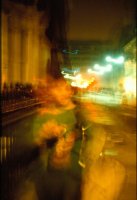What is "Bulb" Photography?
Put simply, it's a technique of photography where the lens of the camera is left open for long enough to capture something not usually seen by the naked eye.
As far as I can tell there is no official "minimum length of time" after which a photo is officially a "bulb photo"
It is not (necessarily) a photo of a light globe or an emerging plant - although oddly enough the former is often a major contributing component in a bulb photo and the latter is often the subject of the loosely related discipline of time lapse photography (animation).
Where did the term "bulb" come from?
I don't know for sure but I can hazard a guess that it has something to do with the fact that many of the earliest cameras used an air based shutter release system.
The shutter was opened when the bulb at the end of a tube was pressed flat and stayed open until the bulb was released. This was of course a fairly inaccurate way of timing a shutter's release but was adequate for the time because longer exposures where necessary due to the limitations of the chemicals and processes used in early days.
For example, in early flash photography, it was not possible to accurately time (synchronise) the ignition of the substance exploded to create the flash, with the lens opening. Hence, subjects sat still (hopefully), the lens was opened, the flash was ignited, the lens closed and, hey presto.
It's fair to say that most photos in the early years of photography were in essence, "bulb photos".
With the advent of newer cameras, chemicals etc it was possible (and desirable) to create mechanically timed shutter releases.
I suspect the "B" setting of these cameras was retained for backwards compatibility as well as to satisfy those who wanted to take photos in low light conditions.
Not suprisingly, most earlier digital cameras did not have a bulb setting. As digital cameras become more sophisticated and more accessible and attractive to those who treat photography as an art, more digital cameras are providing an equivalent to the "B" setting.
How does a photo qualify as "bulb"?
The answer to this is vague - but it's basically time based.
Firstly, any photo taken with the shutter speed of the camera set at "B" has to qualify.
That said, many modern SLRs (single lens reflex cameras) have automatic settings of up to a minute or more. Anything over one second would have to qualify.
But then again. in dark conditions, where there is one or more small but relatively intense light source moving at speed, and this source (or its reflection) is part of the exposure, would also qualify (in my book).
One of the my favourite portaits was taken by a girlfriend with the camera set on "auto". She had no idea what she was doing, and simply grabbed the camera from me and took a shot of me as we both stumbled down a darkened London street. I have no idea how long the shutter was open but, when you look at it, it has to qualify as a long exposure. (I have not invested in a transparency scanner (yet) so unfortunately the quality is not great.)
Note that the above is not a statement of the criteria used for placing photos on this site - it's just an opinion.
Can you do it?
Probably - and you can have a lot of fun experimenting too.
If you have a camera with a "B" shutter setting you can do it.
Most bulb photos on this site where taken with the aid of a tripod and a cable release.
These are the standard tools of the trade and are required if you want at least part of the image to remain in focus.


